Company Accounting
VerifiedAdded on 2023/04/21
|10
|2609
|449
AI Summary
This document provides insights into company accounting, specifically focusing on the importance of fair value in asset valuation. It discusses the classification and impairment of assets and includes a review of the annual report of Medibank Ltd for the year 2018.
Contribute Materials
Your contribution can guide someone’s learning journey. Share your
documents today.
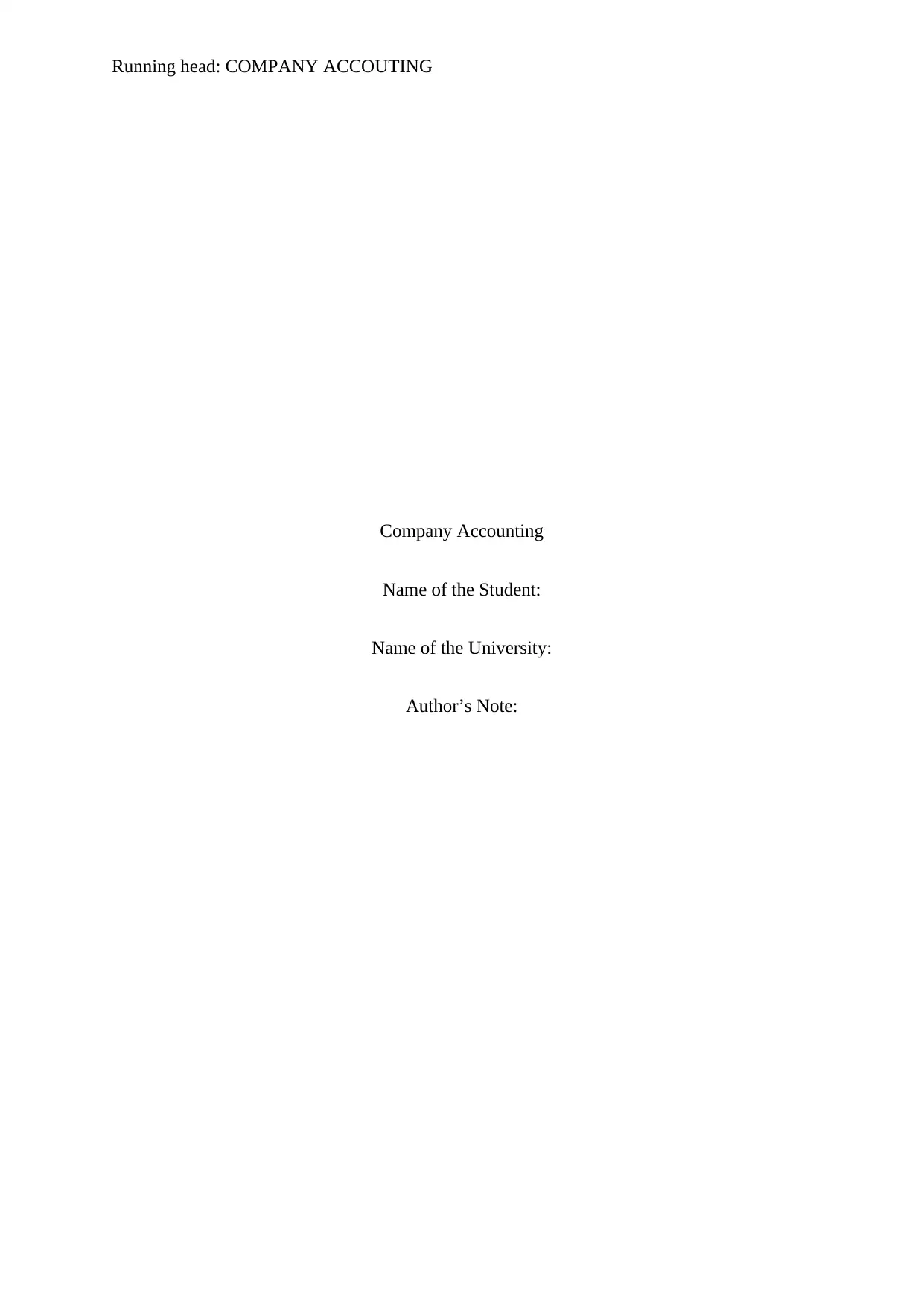
Running head: COMPANY ACCOUTING
Company Accounting
Name of the Student:
Name of the University:
Author’s Note:
Company Accounting
Name of the Student:
Name of the University:
Author’s Note:
Secure Best Marks with AI Grader
Need help grading? Try our AI Grader for instant feedback on your assignments.
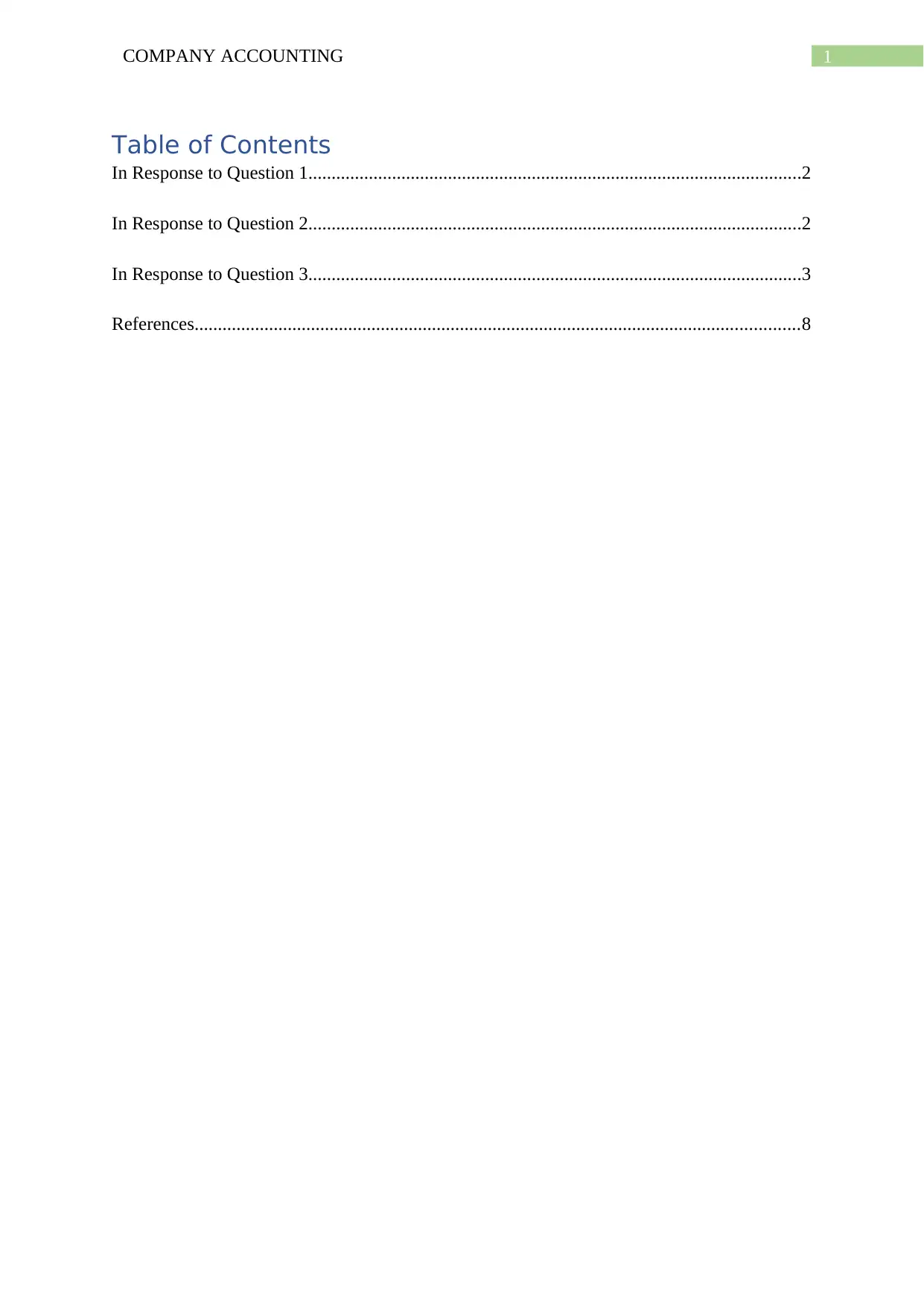
1COMPANY ACCOUNTING
Table of Contents
In Response to Question 1..........................................................................................................2
In Response to Question 2..........................................................................................................2
In Response to Question 3..........................................................................................................3
References..................................................................................................................................8
Table of Contents
In Response to Question 1..........................................................................................................2
In Response to Question 2..........................................................................................................2
In Response to Question 3..........................................................................................................3
References..................................................................................................................................8
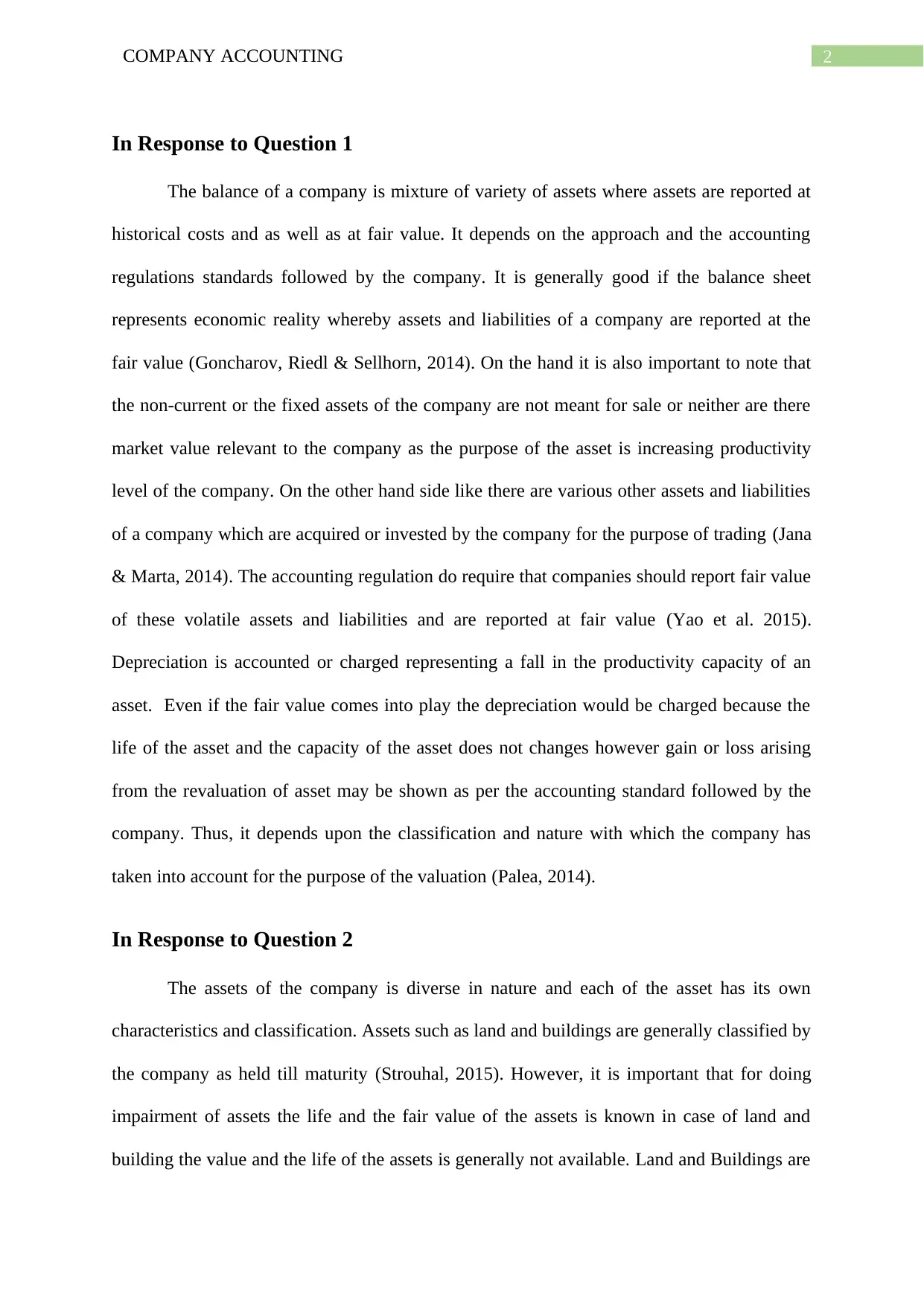
2COMPANY ACCOUNTING
In Response to Question 1
The balance of a company is mixture of variety of assets where assets are reported at
historical costs and as well as at fair value. It depends on the approach and the accounting
regulations standards followed by the company. It is generally good if the balance sheet
represents economic reality whereby assets and liabilities of a company are reported at the
fair value (Goncharov, Riedl & Sellhorn, 2014). On the hand it is also important to note that
the non-current or the fixed assets of the company are not meant for sale or neither are there
market value relevant to the company as the purpose of the asset is increasing productivity
level of the company. On the other hand side like there are various other assets and liabilities
of a company which are acquired or invested by the company for the purpose of trading (Jana
& Marta, 2014). The accounting regulation do require that companies should report fair value
of these volatile assets and liabilities and are reported at fair value (Yao et al. 2015).
Depreciation is accounted or charged representing a fall in the productivity capacity of an
asset. Even if the fair value comes into play the depreciation would be charged because the
life of the asset and the capacity of the asset does not changes however gain or loss arising
from the revaluation of asset may be shown as per the accounting standard followed by the
company. Thus, it depends upon the classification and nature with which the company has
taken into account for the purpose of the valuation (Palea, 2014).
In Response to Question 2
The assets of the company is diverse in nature and each of the asset has its own
characteristics and classification. Assets such as land and buildings are generally classified by
the company as held till maturity (Strouhal, 2015). However, it is important that for doing
impairment of assets the life and the fair value of the assets is known in case of land and
building the value and the life of the assets is generally not available. Land and Buildings are
In Response to Question 1
The balance of a company is mixture of variety of assets where assets are reported at
historical costs and as well as at fair value. It depends on the approach and the accounting
regulations standards followed by the company. It is generally good if the balance sheet
represents economic reality whereby assets and liabilities of a company are reported at the
fair value (Goncharov, Riedl & Sellhorn, 2014). On the hand it is also important to note that
the non-current or the fixed assets of the company are not meant for sale or neither are there
market value relevant to the company as the purpose of the asset is increasing productivity
level of the company. On the other hand side like there are various other assets and liabilities
of a company which are acquired or invested by the company for the purpose of trading (Jana
& Marta, 2014). The accounting regulation do require that companies should report fair value
of these volatile assets and liabilities and are reported at fair value (Yao et al. 2015).
Depreciation is accounted or charged representing a fall in the productivity capacity of an
asset. Even if the fair value comes into play the depreciation would be charged because the
life of the asset and the capacity of the asset does not changes however gain or loss arising
from the revaluation of asset may be shown as per the accounting standard followed by the
company. Thus, it depends upon the classification and nature with which the company has
taken into account for the purpose of the valuation (Palea, 2014).
In Response to Question 2
The assets of the company is diverse in nature and each of the asset has its own
characteristics and classification. Assets such as land and buildings are generally classified by
the company as held till maturity (Strouhal, 2015). However, it is important that for doing
impairment of assets the life and the fair value of the assets is known in case of land and
building the value and the life of the assets is generally not available. Land and Buildings are
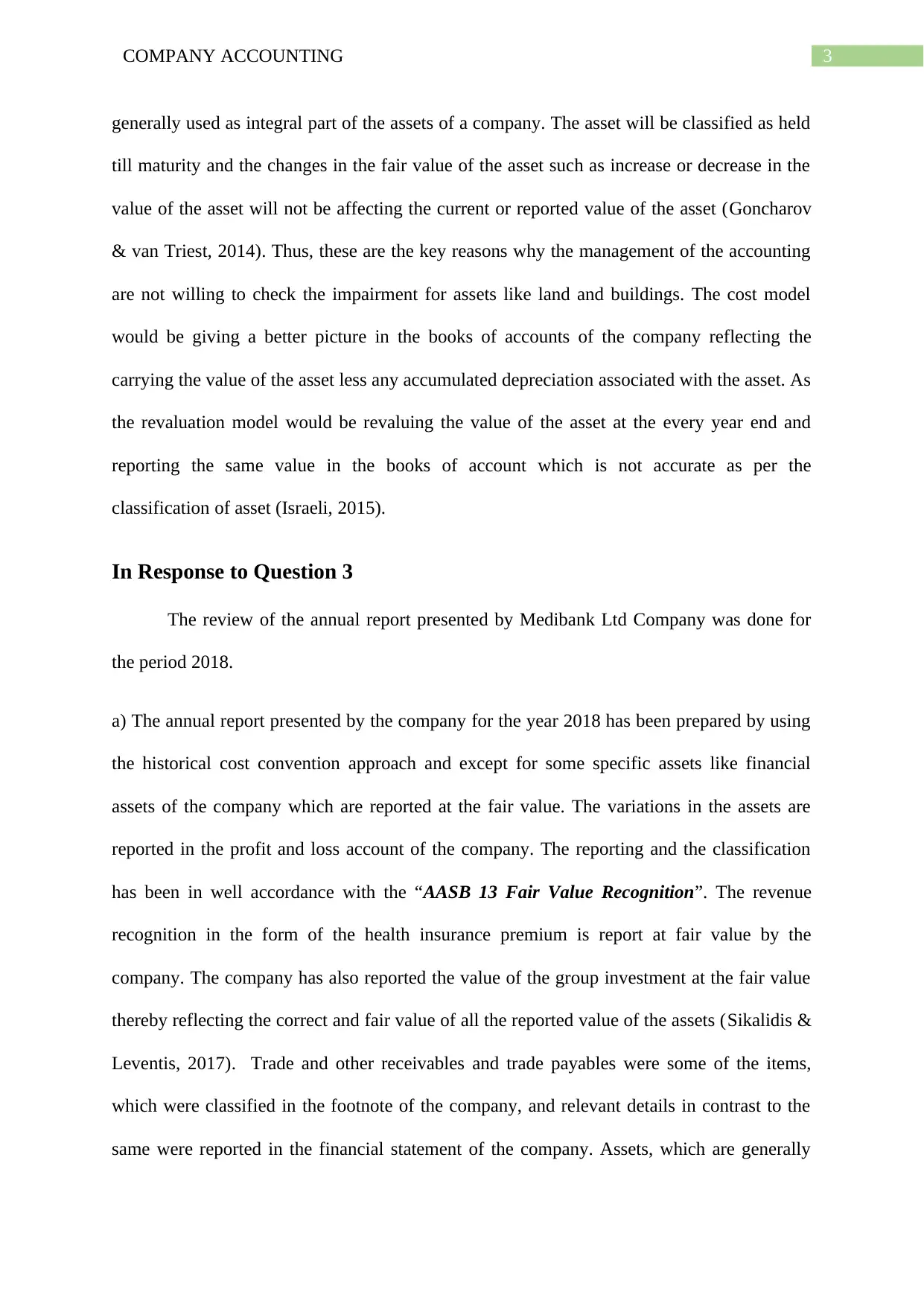
3COMPANY ACCOUNTING
generally used as integral part of the assets of a company. The asset will be classified as held
till maturity and the changes in the fair value of the asset such as increase or decrease in the
value of the asset will not be affecting the current or reported value of the asset (Goncharov
& van Triest, 2014). Thus, these are the key reasons why the management of the accounting
are not willing to check the impairment for assets like land and buildings. The cost model
would be giving a better picture in the books of accounts of the company reflecting the
carrying the value of the asset less any accumulated depreciation associated with the asset. As
the revaluation model would be revaluing the value of the asset at the every year end and
reporting the same value in the books of account which is not accurate as per the
classification of asset (Israeli, 2015).
In Response to Question 3
The review of the annual report presented by Medibank Ltd Company was done for
the period 2018.
a) The annual report presented by the company for the year 2018 has been prepared by using
the historical cost convention approach and except for some specific assets like financial
assets of the company which are reported at the fair value. The variations in the assets are
reported in the profit and loss account of the company. The reporting and the classification
has been in well accordance with the “AASB 13 Fair Value Recognition”. The revenue
recognition in the form of the health insurance premium is report at fair value by the
company. The company has also reported the value of the group investment at the fair value
thereby reflecting the correct and fair value of all the reported value of the assets (Sikalidis &
Leventis, 2017). Trade and other receivables and trade payables were some of the items,
which were classified in the footnote of the company, and relevant details in contrast to the
same were reported in the financial statement of the company. Assets, which are generally
generally used as integral part of the assets of a company. The asset will be classified as held
till maturity and the changes in the fair value of the asset such as increase or decrease in the
value of the asset will not be affecting the current or reported value of the asset (Goncharov
& van Triest, 2014). Thus, these are the key reasons why the management of the accounting
are not willing to check the impairment for assets like land and buildings. The cost model
would be giving a better picture in the books of accounts of the company reflecting the
carrying the value of the asset less any accumulated depreciation associated with the asset. As
the revaluation model would be revaluing the value of the asset at the every year end and
reporting the same value in the books of account which is not accurate as per the
classification of asset (Israeli, 2015).
In Response to Question 3
The review of the annual report presented by Medibank Ltd Company was done for
the period 2018.
a) The annual report presented by the company for the year 2018 has been prepared by using
the historical cost convention approach and except for some specific assets like financial
assets of the company which are reported at the fair value. The variations in the assets are
reported in the profit and loss account of the company. The reporting and the classification
has been in well accordance with the “AASB 13 Fair Value Recognition”. The revenue
recognition in the form of the health insurance premium is report at fair value by the
company. The company has also reported the value of the group investment at the fair value
thereby reflecting the correct and fair value of all the reported value of the assets (Sikalidis &
Leventis, 2017). Trade and other receivables and trade payables were some of the items,
which were classified in the footnote of the company, and relevant details in contrast to the
same were reported in the financial statement of the company. Assets, which are generally
Secure Best Marks with AI Grader
Need help grading? Try our AI Grader for instant feedback on your assignments.
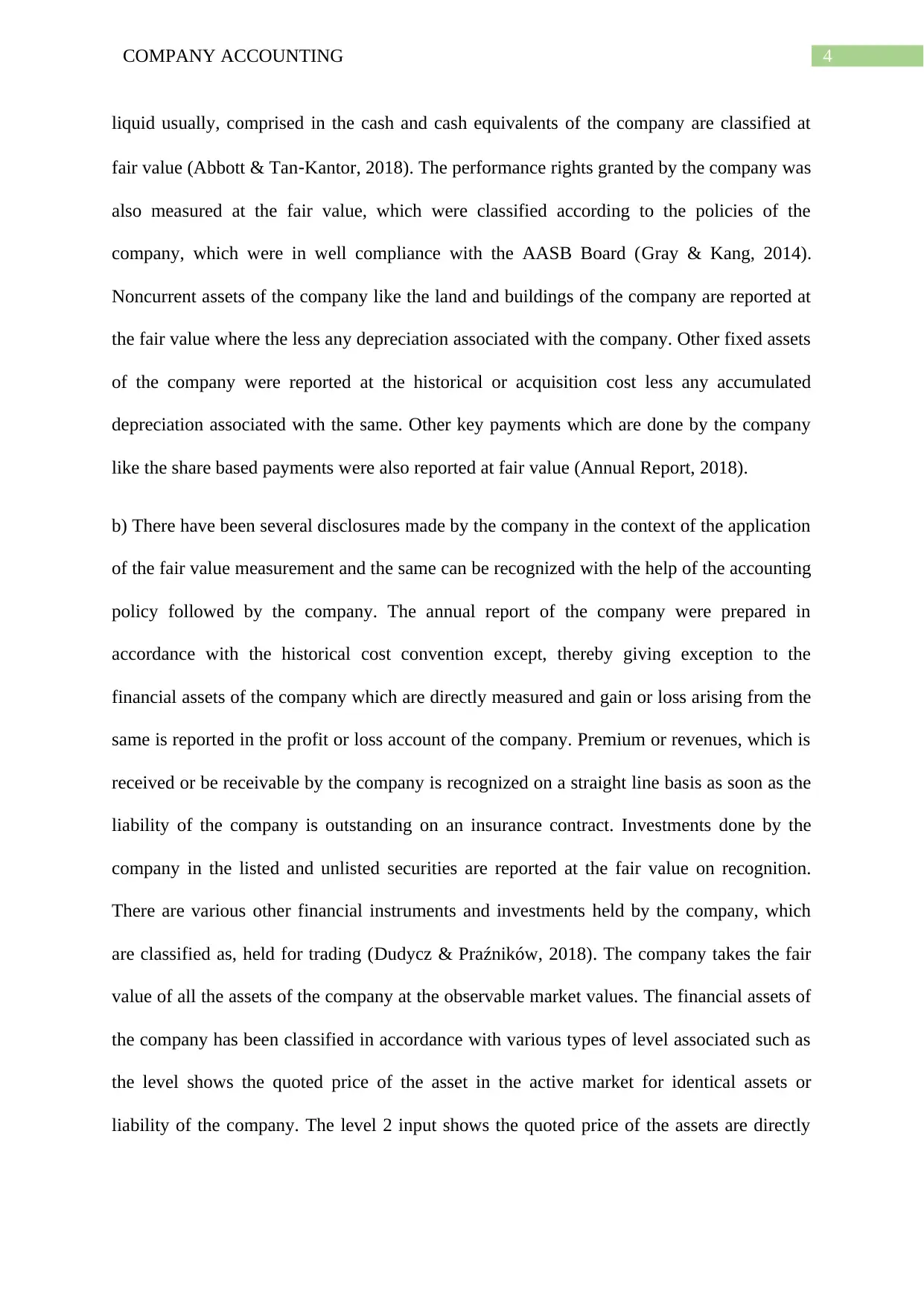
4COMPANY ACCOUNTING
liquid usually, comprised in the cash and cash equivalents of the company are classified at
fair value (Abbott & Tan‐Kantor, 2018). The performance rights granted by the company was
also measured at the fair value, which were classified according to the policies of the
company, which were in well compliance with the AASB Board (Gray & Kang, 2014).
Noncurrent assets of the company like the land and buildings of the company are reported at
the fair value where the less any depreciation associated with the company. Other fixed assets
of the company were reported at the historical or acquisition cost less any accumulated
depreciation associated with the same. Other key payments which are done by the company
like the share based payments were also reported at fair value (Annual Report, 2018).
b) There have been several disclosures made by the company in the context of the application
of the fair value measurement and the same can be recognized with the help of the accounting
policy followed by the company. The annual report of the company were prepared in
accordance with the historical cost convention except, thereby giving exception to the
financial assets of the company which are directly measured and gain or loss arising from the
same is reported in the profit or loss account of the company. Premium or revenues, which is
received or be receivable by the company is recognized on a straight line basis as soon as the
liability of the company is outstanding on an insurance contract. Investments done by the
company in the listed and unlisted securities are reported at the fair value on recognition.
There are various other financial instruments and investments held by the company, which
are classified as, held for trading (Dudycz & Praźników, 2018). The company takes the fair
value of all the assets of the company at the observable market values. The financial assets of
the company has been classified in accordance with various types of level associated such as
the level shows the quoted price of the asset in the active market for identical assets or
liability of the company. The level 2 input shows the quoted price of the assets are directly
liquid usually, comprised in the cash and cash equivalents of the company are classified at
fair value (Abbott & Tan‐Kantor, 2018). The performance rights granted by the company was
also measured at the fair value, which were classified according to the policies of the
company, which were in well compliance with the AASB Board (Gray & Kang, 2014).
Noncurrent assets of the company like the land and buildings of the company are reported at
the fair value where the less any depreciation associated with the company. Other fixed assets
of the company were reported at the historical or acquisition cost less any accumulated
depreciation associated with the same. Other key payments which are done by the company
like the share based payments were also reported at fair value (Annual Report, 2018).
b) There have been several disclosures made by the company in the context of the application
of the fair value measurement and the same can be recognized with the help of the accounting
policy followed by the company. The annual report of the company were prepared in
accordance with the historical cost convention except, thereby giving exception to the
financial assets of the company which are directly measured and gain or loss arising from the
same is reported in the profit or loss account of the company. Premium or revenues, which is
received or be receivable by the company is recognized on a straight line basis as soon as the
liability of the company is outstanding on an insurance contract. Investments done by the
company in the listed and unlisted securities are reported at the fair value on recognition.
There are various other financial instruments and investments held by the company, which
are classified as, held for trading (Dudycz & Praźników, 2018). The company takes the fair
value of all the assets of the company at the observable market values. The financial assets of
the company has been classified in accordance with various types of level associated such as
the level shows the quoted price of the asset in the active market for identical assets or
liability of the company. The level 2 input shows the quoted price of the assets are directly
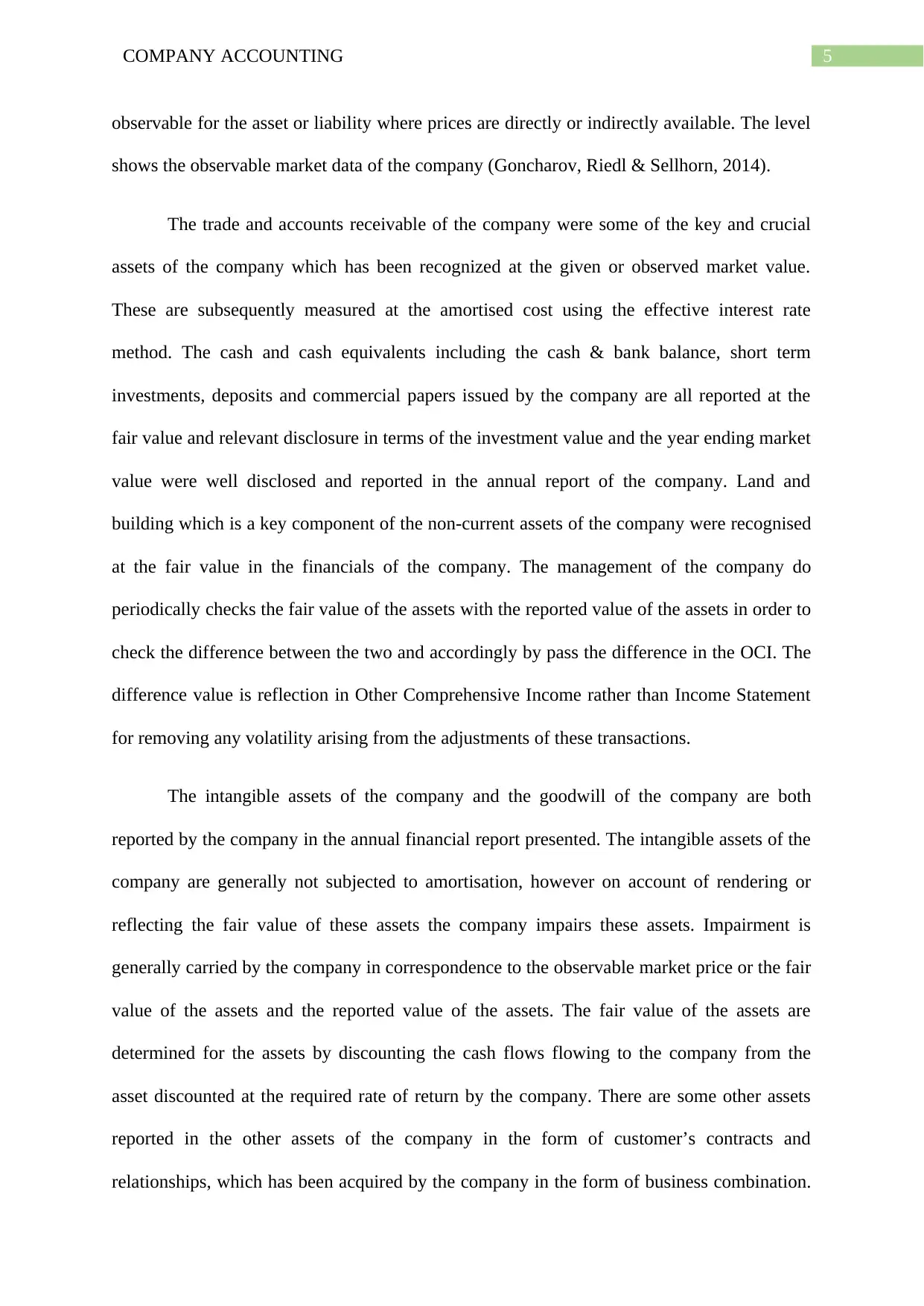
5COMPANY ACCOUNTING
observable for the asset or liability where prices are directly or indirectly available. The level
shows the observable market data of the company (Goncharov, Riedl & Sellhorn, 2014).
The trade and accounts receivable of the company were some of the key and crucial
assets of the company which has been recognized at the given or observed market value.
These are subsequently measured at the amortised cost using the effective interest rate
method. The cash and cash equivalents including the cash & bank balance, short term
investments, deposits and commercial papers issued by the company are all reported at the
fair value and relevant disclosure in terms of the investment value and the year ending market
value were well disclosed and reported in the annual report of the company. Land and
building which is a key component of the non-current assets of the company were recognised
at the fair value in the financials of the company. The management of the company do
periodically checks the fair value of the assets with the reported value of the assets in order to
check the difference between the two and accordingly by pass the difference in the OCI. The
difference value is reflection in Other Comprehensive Income rather than Income Statement
for removing any volatility arising from the adjustments of these transactions.
The intangible assets of the company and the goodwill of the company are both
reported by the company in the annual financial report presented. The intangible assets of the
company are generally not subjected to amortisation, however on account of rendering or
reflecting the fair value of these assets the company impairs these assets. Impairment is
generally carried by the company in correspondence to the observable market price or the fair
value of the assets and the reported value of the assets. The fair value of the assets are
determined for the assets by discounting the cash flows flowing to the company from the
asset discounted at the required rate of return by the company. There are some other assets
reported in the other assets of the company in the form of customer’s contracts and
relationships, which has been acquired by the company in the form of business combination.
observable for the asset or liability where prices are directly or indirectly available. The level
shows the observable market data of the company (Goncharov, Riedl & Sellhorn, 2014).
The trade and accounts receivable of the company were some of the key and crucial
assets of the company which has been recognized at the given or observed market value.
These are subsequently measured at the amortised cost using the effective interest rate
method. The cash and cash equivalents including the cash & bank balance, short term
investments, deposits and commercial papers issued by the company are all reported at the
fair value and relevant disclosure in terms of the investment value and the year ending market
value were well disclosed and reported in the annual report of the company. Land and
building which is a key component of the non-current assets of the company were recognised
at the fair value in the financials of the company. The management of the company do
periodically checks the fair value of the assets with the reported value of the assets in order to
check the difference between the two and accordingly by pass the difference in the OCI. The
difference value is reflection in Other Comprehensive Income rather than Income Statement
for removing any volatility arising from the adjustments of these transactions.
The intangible assets of the company and the goodwill of the company are both
reported by the company in the annual financial report presented. The intangible assets of the
company are generally not subjected to amortisation, however on account of rendering or
reflecting the fair value of these assets the company impairs these assets. Impairment is
generally carried by the company in correspondence to the observable market price or the fair
value of the assets and the reported value of the assets. The fair value of the assets are
determined for the assets by discounting the cash flows flowing to the company from the
asset discounted at the required rate of return by the company. There are some other assets
reported in the other assets of the company in the form of customer’s contracts and
relationships, which has been acquired by the company in the form of business combination.
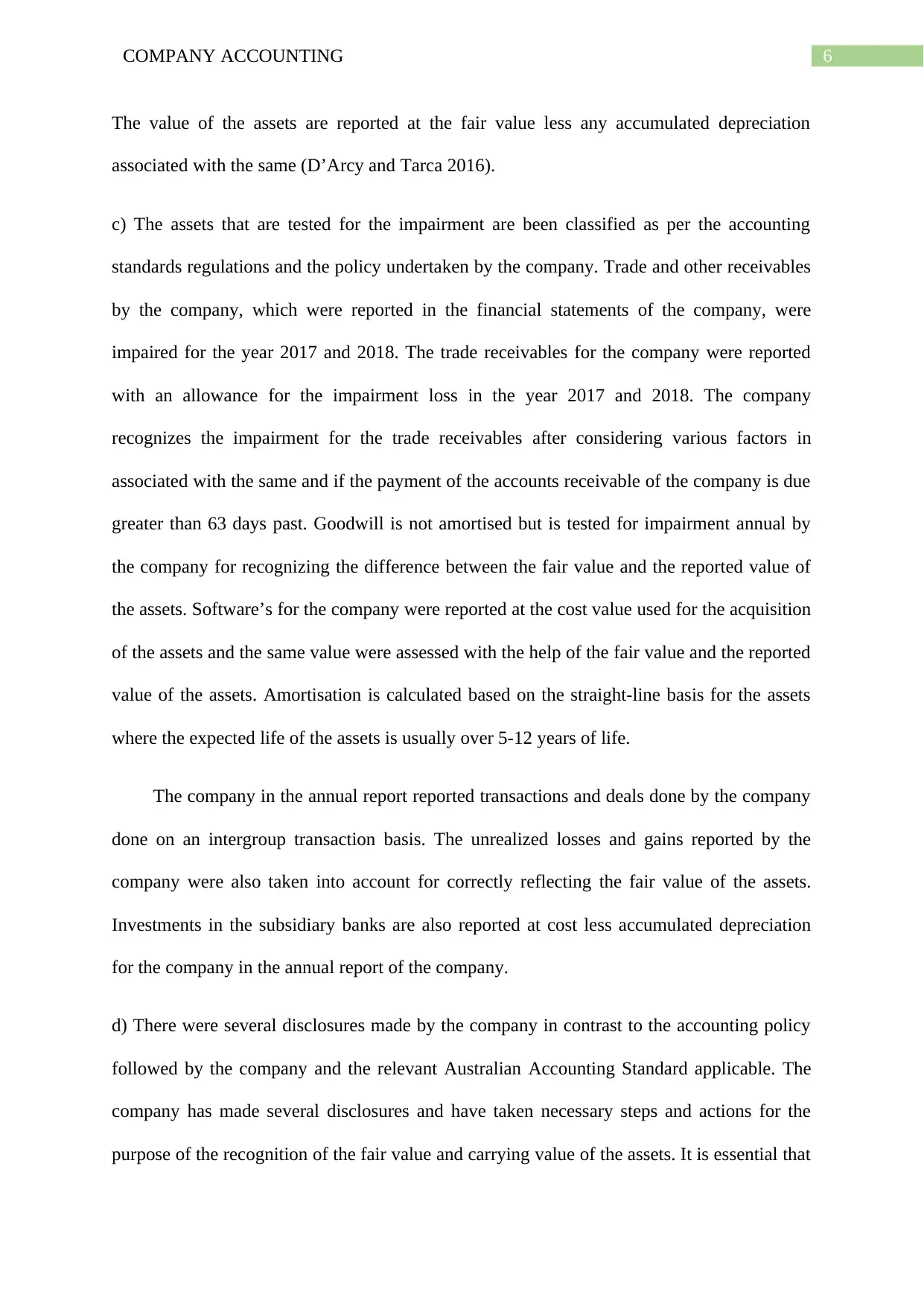
6COMPANY ACCOUNTING
The value of the assets are reported at the fair value less any accumulated depreciation
associated with the same (D’Arcy and Tarca 2016).
c) The assets that are tested for the impairment are been classified as per the accounting
standards regulations and the policy undertaken by the company. Trade and other receivables
by the company, which were reported in the financial statements of the company, were
impaired for the year 2017 and 2018. The trade receivables for the company were reported
with an allowance for the impairment loss in the year 2017 and 2018. The company
recognizes the impairment for the trade receivables after considering various factors in
associated with the same and if the payment of the accounts receivable of the company is due
greater than 63 days past. Goodwill is not amortised but is tested for impairment annual by
the company for recognizing the difference between the fair value and the reported value of
the assets. Software’s for the company were reported at the cost value used for the acquisition
of the assets and the same value were assessed with the help of the fair value and the reported
value of the assets. Amortisation is calculated based on the straight-line basis for the assets
where the expected life of the assets is usually over 5-12 years of life.
The company in the annual report reported transactions and deals done by the company
done on an intergroup transaction basis. The unrealized losses and gains reported by the
company were also taken into account for correctly reflecting the fair value of the assets.
Investments in the subsidiary banks are also reported at cost less accumulated depreciation
for the company in the annual report of the company.
d) There were several disclosures made by the company in contrast to the accounting policy
followed by the company and the relevant Australian Accounting Standard applicable. The
company has made several disclosures and have taken necessary steps and actions for the
purpose of the recognition of the fair value and carrying value of the assets. It is essential that
The value of the assets are reported at the fair value less any accumulated depreciation
associated with the same (D’Arcy and Tarca 2016).
c) The assets that are tested for the impairment are been classified as per the accounting
standards regulations and the policy undertaken by the company. Trade and other receivables
by the company, which were reported in the financial statements of the company, were
impaired for the year 2017 and 2018. The trade receivables for the company were reported
with an allowance for the impairment loss in the year 2017 and 2018. The company
recognizes the impairment for the trade receivables after considering various factors in
associated with the same and if the payment of the accounts receivable of the company is due
greater than 63 days past. Goodwill is not amortised but is tested for impairment annual by
the company for recognizing the difference between the fair value and the reported value of
the assets. Software’s for the company were reported at the cost value used for the acquisition
of the assets and the same value were assessed with the help of the fair value and the reported
value of the assets. Amortisation is calculated based on the straight-line basis for the assets
where the expected life of the assets is usually over 5-12 years of life.
The company in the annual report reported transactions and deals done by the company
done on an intergroup transaction basis. The unrealized losses and gains reported by the
company were also taken into account for correctly reflecting the fair value of the assets.
Investments in the subsidiary banks are also reported at cost less accumulated depreciation
for the company in the annual report of the company.
d) There were several disclosures made by the company in contrast to the accounting policy
followed by the company and the relevant Australian Accounting Standard applicable. The
company has made several disclosures and have taken necessary steps and actions for the
purpose of the recognition of the fair value and carrying value of the assets. It is essential that
Paraphrase This Document
Need a fresh take? Get an instant paraphrase of this document with our AI Paraphraser
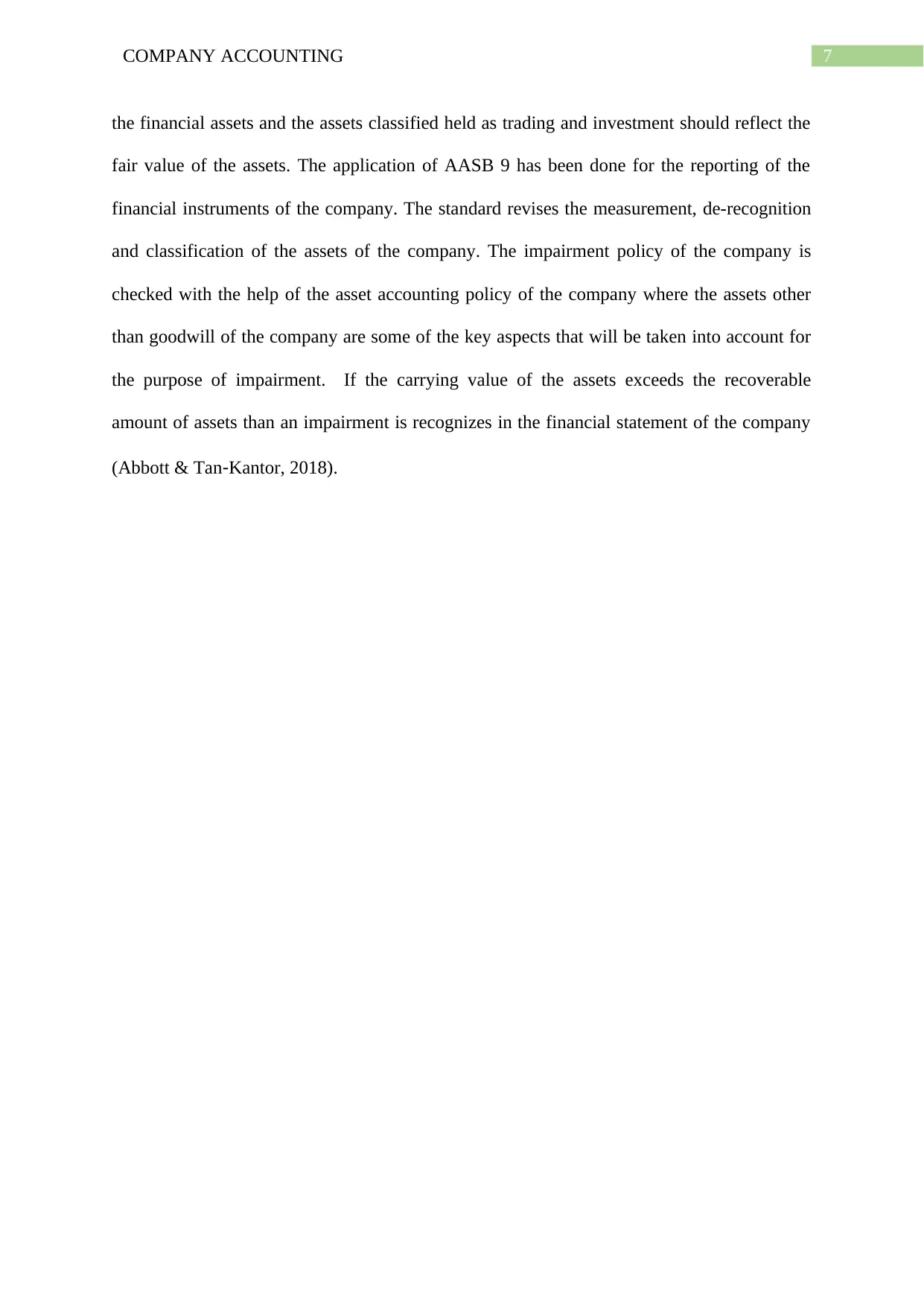
7COMPANY ACCOUNTING
the financial assets and the assets classified held as trading and investment should reflect the
fair value of the assets. The application of AASB 9 has been done for the reporting of the
financial instruments of the company. The standard revises the measurement, de-recognition
and classification of the assets of the company. The impairment policy of the company is
checked with the help of the asset accounting policy of the company where the assets other
than goodwill of the company are some of the key aspects that will be taken into account for
the purpose of impairment. If the carrying value of the assets exceeds the recoverable
amount of assets than an impairment is recognizes in the financial statement of the company
(Abbott & Tan‐Kantor, 2018).
the financial assets and the assets classified held as trading and investment should reflect the
fair value of the assets. The application of AASB 9 has been done for the reporting of the
financial instruments of the company. The standard revises the measurement, de-recognition
and classification of the assets of the company. The impairment policy of the company is
checked with the help of the asset accounting policy of the company where the assets other
than goodwill of the company are some of the key aspects that will be taken into account for
the purpose of impairment. If the carrying value of the assets exceeds the recoverable
amount of assets than an impairment is recognizes in the financial statement of the company
(Abbott & Tan‐Kantor, 2018).
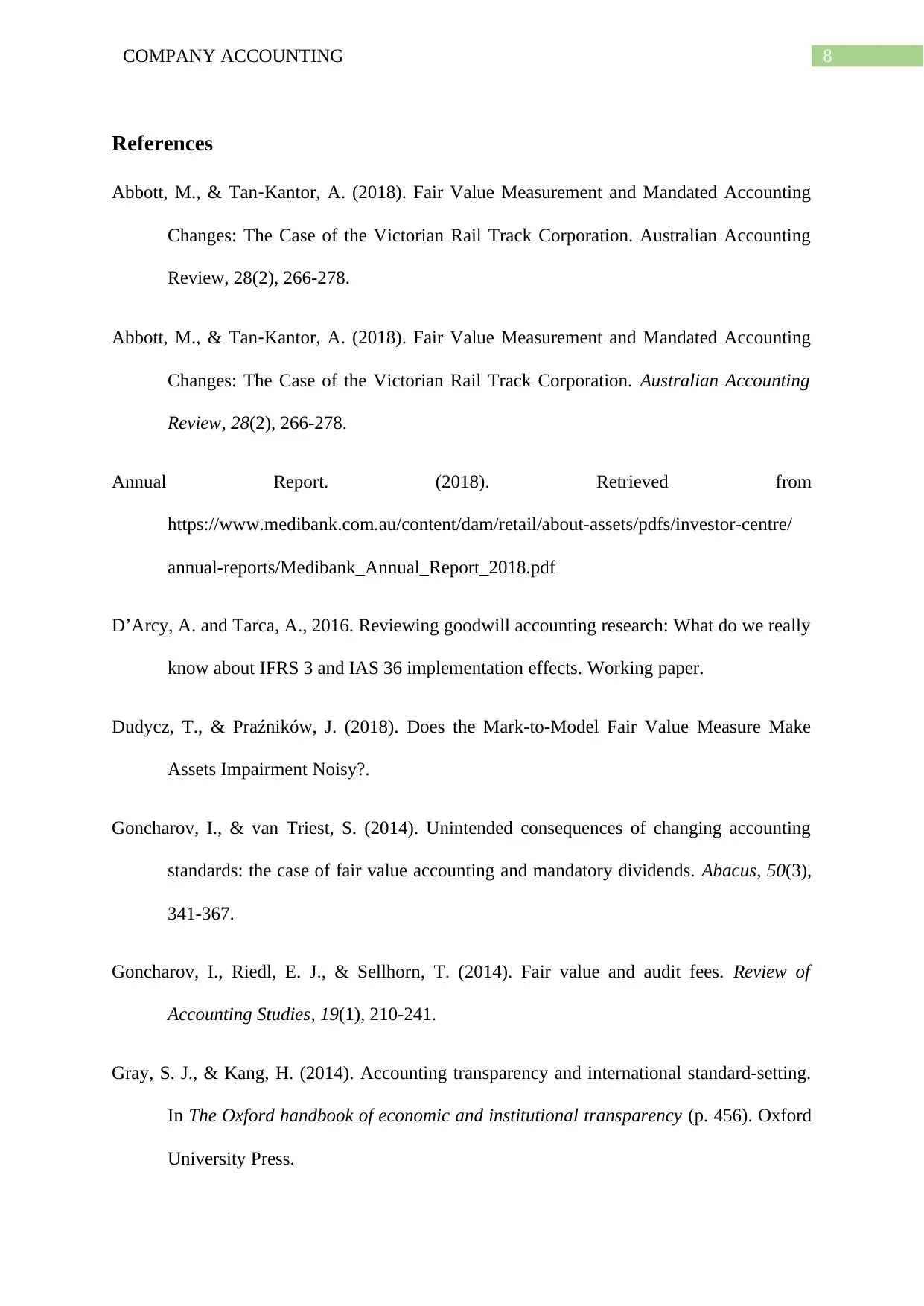
8COMPANY ACCOUNTING
References
Abbott, M., & Tan‐Kantor, A. (2018). Fair Value Measurement and Mandated Accounting
Changes: The Case of the Victorian Rail Track Corporation. Australian Accounting
Review, 28(2), 266-278.
Abbott, M., & Tan‐Kantor, A. (2018). Fair Value Measurement and Mandated Accounting
Changes: The Case of the Victorian Rail Track Corporation. Australian Accounting
Review, 28(2), 266-278.
Annual Report. (2018). Retrieved from
https://www.medibank.com.au/content/dam/retail/about-assets/pdfs/investor-centre/
annual-reports/Medibank_Annual_Report_2018.pdf
D’Arcy, A. and Tarca, A., 2016. Reviewing goodwill accounting research: What do we really
know about IFRS 3 and IAS 36 implementation effects. Working paper.
Dudycz, T., & Praźników, J. (2018). Does the Mark-to-Model Fair Value Measure Make
Assets Impairment Noisy?.
Goncharov, I., & van Triest, S. (2014). Unintended consequences of changing accounting
standards: the case of fair value accounting and mandatory dividends. Abacus, 50(3),
341-367.
Goncharov, I., Riedl, E. J., & Sellhorn, T. (2014). Fair value and audit fees. Review of
Accounting Studies, 19(1), 210-241.
Gray, S. J., & Kang, H. (2014). Accounting transparency and international standard-setting.
In The Oxford handbook of economic and institutional transparency (p. 456). Oxford
University Press.
References
Abbott, M., & Tan‐Kantor, A. (2018). Fair Value Measurement and Mandated Accounting
Changes: The Case of the Victorian Rail Track Corporation. Australian Accounting
Review, 28(2), 266-278.
Abbott, M., & Tan‐Kantor, A. (2018). Fair Value Measurement and Mandated Accounting
Changes: The Case of the Victorian Rail Track Corporation. Australian Accounting
Review, 28(2), 266-278.
Annual Report. (2018). Retrieved from
https://www.medibank.com.au/content/dam/retail/about-assets/pdfs/investor-centre/
annual-reports/Medibank_Annual_Report_2018.pdf
D’Arcy, A. and Tarca, A., 2016. Reviewing goodwill accounting research: What do we really
know about IFRS 3 and IAS 36 implementation effects. Working paper.
Dudycz, T., & Praźników, J. (2018). Does the Mark-to-Model Fair Value Measure Make
Assets Impairment Noisy?.
Goncharov, I., & van Triest, S. (2014). Unintended consequences of changing accounting
standards: the case of fair value accounting and mandatory dividends. Abacus, 50(3),
341-367.
Goncharov, I., Riedl, E. J., & Sellhorn, T. (2014). Fair value and audit fees. Review of
Accounting Studies, 19(1), 210-241.
Gray, S. J., & Kang, H. (2014). Accounting transparency and international standard-setting.
In The Oxford handbook of economic and institutional transparency (p. 456). Oxford
University Press.
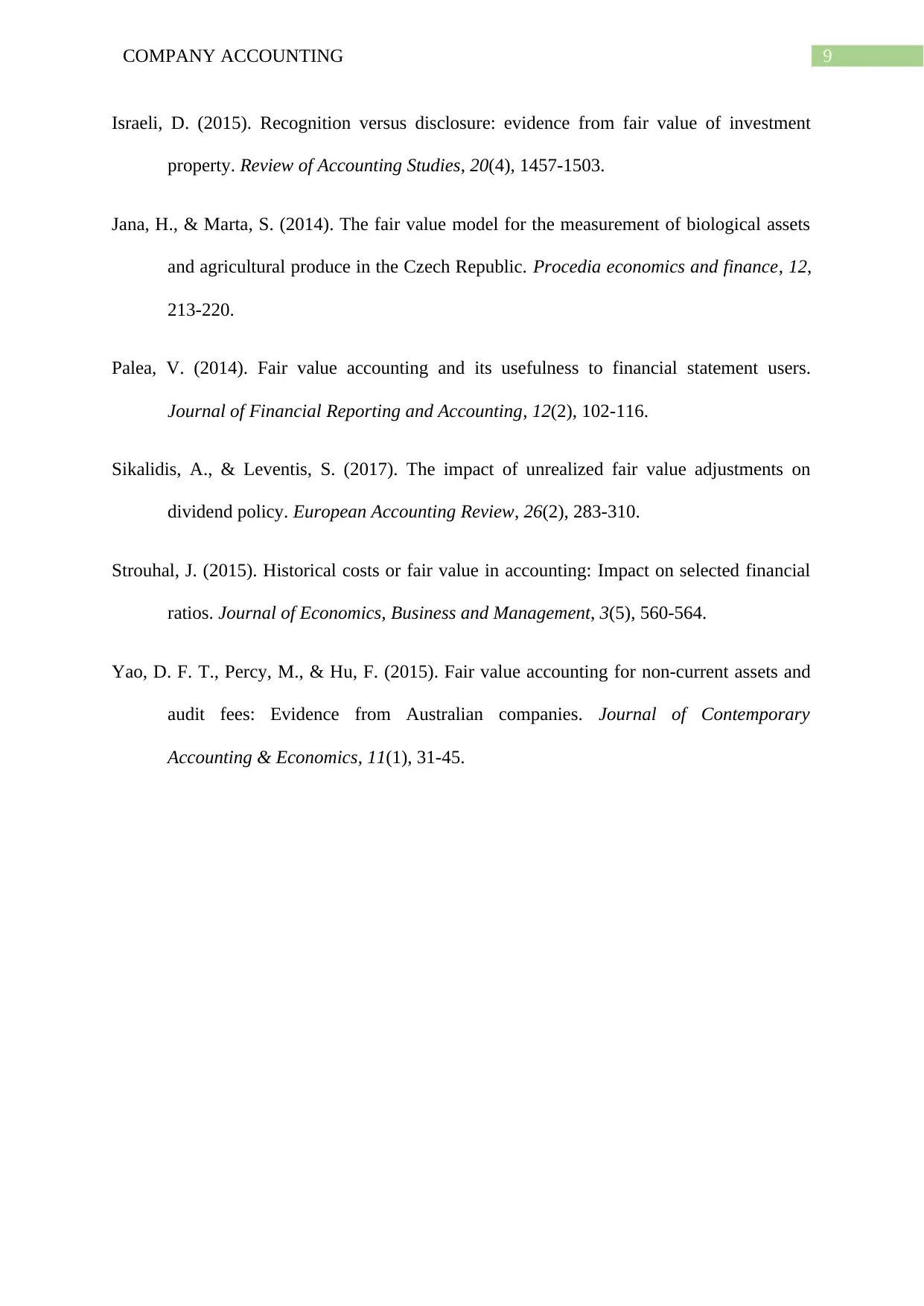
9COMPANY ACCOUNTING
Israeli, D. (2015). Recognition versus disclosure: evidence from fair value of investment
property. Review of Accounting Studies, 20(4), 1457-1503.
Jana, H., & Marta, S. (2014). The fair value model for the measurement of biological assets
and agricultural produce in the Czech Republic. Procedia economics and finance, 12,
213-220.
Palea, V. (2014). Fair value accounting and its usefulness to financial statement users.
Journal of Financial Reporting and Accounting, 12(2), 102-116.
Sikalidis, A., & Leventis, S. (2017). The impact of unrealized fair value adjustments on
dividend policy. European Accounting Review, 26(2), 283-310.
Strouhal, J. (2015). Historical costs or fair value in accounting: Impact on selected financial
ratios. Journal of Economics, Business and Management, 3(5), 560-564.
Yao, D. F. T., Percy, M., & Hu, F. (2015). Fair value accounting for non-current assets and
audit fees: Evidence from Australian companies. Journal of Contemporary
Accounting & Economics, 11(1), 31-45.
Israeli, D. (2015). Recognition versus disclosure: evidence from fair value of investment
property. Review of Accounting Studies, 20(4), 1457-1503.
Jana, H., & Marta, S. (2014). The fair value model for the measurement of biological assets
and agricultural produce in the Czech Republic. Procedia economics and finance, 12,
213-220.
Palea, V. (2014). Fair value accounting and its usefulness to financial statement users.
Journal of Financial Reporting and Accounting, 12(2), 102-116.
Sikalidis, A., & Leventis, S. (2017). The impact of unrealized fair value adjustments on
dividend policy. European Accounting Review, 26(2), 283-310.
Strouhal, J. (2015). Historical costs or fair value in accounting: Impact on selected financial
ratios. Journal of Economics, Business and Management, 3(5), 560-564.
Yao, D. F. T., Percy, M., & Hu, F. (2015). Fair value accounting for non-current assets and
audit fees: Evidence from Australian companies. Journal of Contemporary
Accounting & Economics, 11(1), 31-45.
1 out of 10
Related Documents
Your All-in-One AI-Powered Toolkit for Academic Success.
+13062052269
info@desklib.com
Available 24*7 on WhatsApp / Email
![[object Object]](/_next/static/media/star-bottom.7253800d.svg)
Unlock your academic potential
© 2024 | Zucol Services PVT LTD | All rights reserved.





